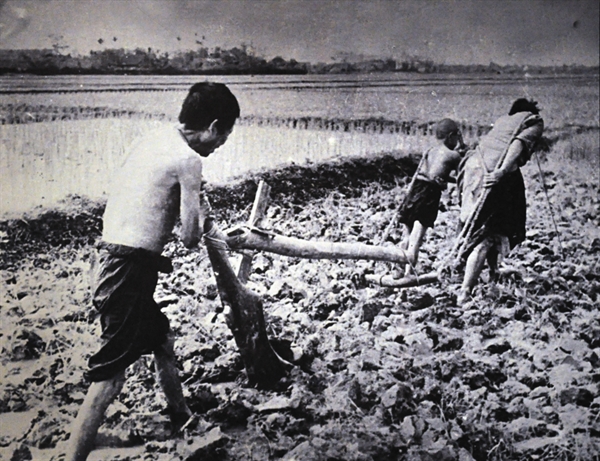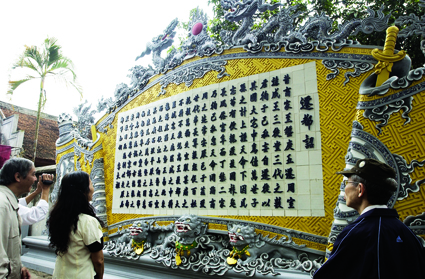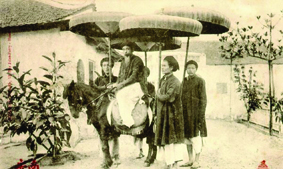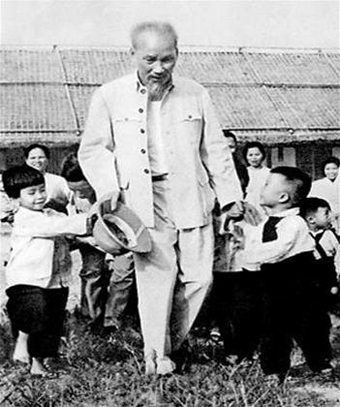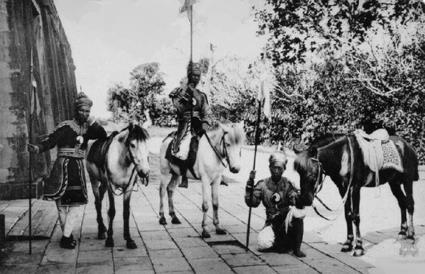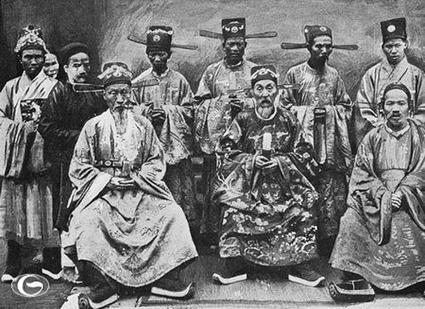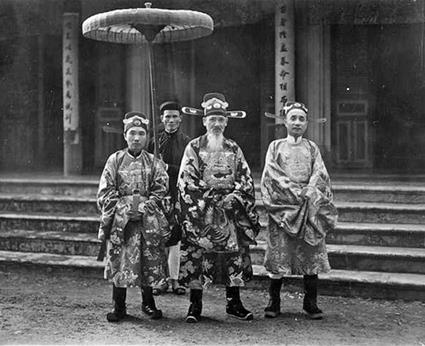MSc. Do Danh Huan
History Institute of Vietnam
The Nguyen dynasty ruled the country from 1802 to 1945 when its last king, Bao Dai, abdicated and handed over the royal seal and sword to the Provisional Revolutionary Government after the August 1945 Revolution succeeded.
Under its reign, the Nguyen dynasty expanded its territory southward, managed the country in every village, developed a legal system, typically the Gia Long Code, and created some worldwide-recognized heritages such as Hue Imperial City, Hue Royal Court Music, and carved wood blocks. Particularly, it carried on the state management, protection and exercise of the national sovereignty over Hoang Sa and Truong Sa archipelagoes.
 |
| Leaders of the Ministry of Information and Communications and 7th military zone command visit an exhibition of maps and historical and legal evidences of Vietnam's Truong Sa and Hoang Sa archipelagoes__Photo: The Anh/VNA |
Coming to the throne in 1802, King Gia Long, though busy with royal affairs, never neglected the mission of protecting and establishing the control over sea and island regions handed down by his forefathers. It is widely known that under the Nguyen Lords’ rule, Hoang Sa and Bac Hai flotillas were set up with crew members largely from Quang Nam and Quang Ngai provinces. Under the reign of the Nguyen Kings, Hoang Sa flotilla was maintained to patrol and control the sea and island regions on behalf of the royal court. Historical documents reveal that all the Nguyen Kings considered Hoang Sa flotilla a vanguard and unique force to enforce the monarchical management of Hoang Sa and Truong Sa archipelagoes.
In 1815, King Gia Long ordered Hoang Sa flotilla, under the command of Pham Quang Anh (a resident of Ly Son island, Quang Ngai province), to cross the sea to Hoang Sa “for the exploration of sea routes.”1
King Minh Mang, who succeeded King Gia Long and ruled the country from 1820 to 1841, continued with the management, patrol and control of Hoang Sa and Truong Sa regions in a more comprehensive and profound manner. According to historical documents, the King organized and sent troops for exploration, management and patrol of sea and island regions through various activities, from map drawing to sovereignty marker planting, temple building, tree planting, etc., as signs of recognition.
In 1834, King Minh Mang ordered “team leader Truong Phuc Si to travel by boat together with more than 20 sailors to Hoang Sa island of Quang Ngai province for map drawing.”2
The King himself time and again sent troops to patrol and control Hoang Sa and Truong Sa regions. Being well aware of the material traces on these groups of islands, the Nguyen dynasty regarded them as part and parcel of the territory under its management. In 1835, after the map drawing was completed, King Minh Mang ordered troops to apply different measures affirming the national sovereignty, as described in the following paragraph:
“On Hoang Sa bank in the territorial waters of Quang Ngai there is a white sand expanse with green trees, a well in the center, an ancient temple in the southwest with a stele engraved with the words “Van ly ba binh” (Tens of thousands of miles in calming waves), which has an ancient name Phat Tu mountain and is measured 1,079 ‘truong’ (a ten-yard measuring unit) in perimeter, and coral reefs winding along its eastern, western and southern coasts. To the north, it borders on a coral reef of 430 ‘truong’ in perimeter and 1.3 ‘truong’ in height, which was called ‘Ban Than’ Rock. Last year, the King ordered erection of a temple and a stele there but this work was not done yet. Now, he dispatched commander Pham Van Nguyen together with soldiers and hired boatmen from Quang Ngai and Binh Dinh provinces to transport building materials there to build a temple (seven ‘truong” away from the ancient temple). To the left of the temple, a stone stele was erected; in front of the temple, a screen was built. The work was completed after 15 days.”3
In 1836, the King ordered Pham Huu Nhat to command a flotilla to go to Hoang Sa for surveying, inspection, marker planting and map drawing.4
Like the previous monarchies, the Nguyen dynasty also organized its state apparatus into six ministries: Bo Hinh (in charge of legal affairs and adjudication); Bo Binh (in charge of military affairs and war); Bo Cong (in charge of construction, repair and dykes); Bo Le (in charge of education, culture and public health); Bo Lai (in charge of management, appointment, posting, recommendation of mandarins); and Bo Ho (in charge of financial and tax matters, household management). For the patrol, control and management of seas and islands, Bo Binh, especially the naval force, was tasked to defend the national sovereignty over sea and island regions while Bo Cong played a certain role in enforcing royal orders. In 1836, in its report, Bo Cong proposed:
“From now on, by the end of every first lunar month, a marine and guard force should be selected and sent to Quang Ngai province in early second moon, asking Quang Ngai and Binh Dinh provinces to hire four boats of local inhabitants to guide the way to Hoang Sa.”5
Once again in 1836, commander Pham Huu Nhat was dispatched to Hoang Sa to protect the national sovereignty. This time, he brought along 10 wood tablets to be erected there as markers; the tablets are engraved with the words: Minh Mang the 17th, the year of Binh Than...”6 Clearly, the planting of these wood tablets is nothing but planting land border markers on Hoang Sa archipelago.
King Minh Mang was fully aware of the role and position of seas and islands in territorial expansion and national defense. He tightened royal discipline and severely punished mandarins who failed to fulfill their duties and rewarded those who did their work well. This can be seen in his decree issued in 1835:
“Particularly, team leader Pham Van Nguyen, who delayed his mission, will receive 80 strokes of the cane. Supervisors Tran Van Van, Nguyen Van Tien, Nguyen Van Hoang, who carelessly drew maps would be punished with 80 strokes of the cane. Marine guides Vo Van Hung and Pham Van Sanh will be rewarded with silver coins; construction soldiers and hired workers from Quang Ngai and Binh Dinh provinces will be rewarded each with a sum of hundred coins.”7
During his short reign (1841-1847), King Thieu Tri, who succeeded Minh Mang, carried on the protection of the national boundaries and islands left behind by his forefathers. He continued to maintain the patrol and control of Hoang Sa archipelago, sending troops there for surveying and mapping.
King Tu Duc sat on the throne from 1847 to 1883 when the country was confronted with the eminent invasion by French colonialists who forced the Royal Court to sign a number of accords recognizing their interests and presence in Vietnam. Hence, the King could not do much for the protection of national seas and islands. However, the monarchy never forgot the country’s territorial waters and islands. “Dai Nam Nhat Thong Chi” (the Geography of Unified Great Vietnam), a book written during King Tu Duc’s rule, reads:
“Hoang Sa lies east of Re islet, which can be reached by boats after three to four days and nights of smooth sail from Sa Ky port. It is composed of more than 130 islands. Found on the archipelago is a vast golden sand bank, stretching for several thousands of miles, which is known as ‘Van ly truong sa’ (Long sand bank of tens of thousands of miles), where the water is crystal clear and a freshwater well found; sea birds gather in great numbers. Also there are various kinds of marine resources such as shellfish, sea cucumber, turtle...”8
From the time of King Thieu Tri on, the Nguyen dynasty had not enough resources and time to prioritize the protection of national territorial waters as French colonialists intervened more deeply into domestic affairs, not to mention many unstable social upheavals then. During their reign, the Nguyen Kings made great efforts in expanding the national territory and firmly defending the air space and sea areas of the country, including the continuous exercise of the national rights to manage Hoang Sa and Truong Sa archipelagos, which were handed down by the previous monarchies. This can been seen as a great achievement recorded by the Nguyen dynasty in the 19th century.
1 The Nguyen Dynasty Historical Bureau, Dai Nam Thuc Luc Chinh Bien (Veritable Records of Great Vietnam), vol. IV, History Publishing House, Hanoi, 1963, p.245.
2 The Nguyen Dynasty Historical Bureau, Dai Nam Thuc Luc Chinh Bien, vol. IV, Education Publishing House, 2007, p.120.
3 The Nguyen Dynasty Historical Bureau, Dai Nam Thuc Luc Chinh Bien, vol. IV, Education Publishing House, 2007, p. 673.
4 The Nguyen Dynasty Historical Bureau, Quoc Trieu chinh bien toat yeu (Official Accounts of Dynasties), Thuan Hoa Publishing House, 1998, p. 274.
5 The Nguyen Dynasty Historical Bureau, Dai Nam Thuc Luc Chinh Bien, vol. IV, Education Publishing House, 2007. p.867.
6 Ibid, p.867.
7 “Xua va Nay” (Past and Present) Review, Issue No. 63B, 1999, p.20-21.
8 The Nguyen Dynasty Historical Bureau, Dai Nam Nhat Thong Chi (Geography of the Unified Great Vietnam), Thuan Hoa Publishing House, 1992, p. 422.

